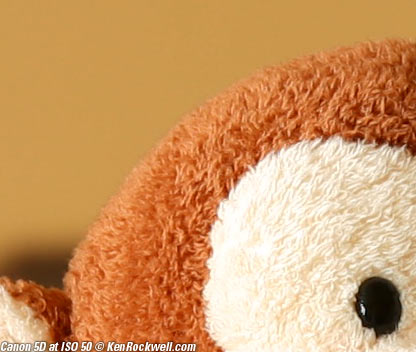Nikon D300, D200, D40 and Canon 5D High ISO Comparison
© 2007 KenRockwell.com
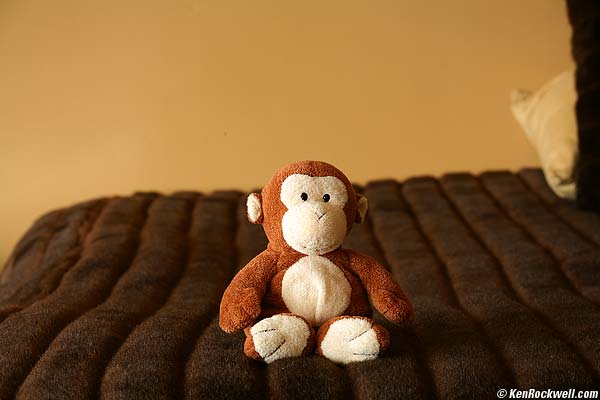
Self Portrait. (also the full image from which the crops are taken.)
I get my
goodies at Ritz, Amazon, Adorama.
It helps me
keep adding to this site when you get yours from those
links, too.
November 2007
Every time the wankers get to me, I round up the relevant DSLRs I have sitting around and have a shoot out. See the same thing with the Canon 40D, 5D, Rebel XTi and Nikon D40 and D200 from last month, D300 vs. D200 in Moonlight, and 2006's comparison, for example.
This week it's the Nikon D300, D200 and D40 against the Canon 5D, just because that's what's sitting here. If the Nikon D3 ever materializes, I'll do this again.
This compares all cameras on the same grounds: same shot, same tripod, same exposure, same angle of view, same final print size (tech details below). All of these would print at 43" (1.1m) wide if you printed the entire portrait at the magnification shown below. I rarely print this big; do you?
Any idiot can make shots with one camera at a time and sling them all over the Internet. It takes a more dedicated idiot (like me) to assemble everything and set everything as similarly as I could to shoot these cameras against each other under identical conditions. This is the only way to make a valid comparison. It takes another half-day to format everything in Photoshop and assemble this page to share the results.
Use the "skip to ISO" links to switch instantly among the various ISOs and you'll see how they vary.
Many thanks go to photographer Moose Peterson, who suggested in one of his excellent books to practice your big-game photography with stuffed animals. He's right: they make very willing subjects and do an excellent job of representing wildlife for playing with settings.
See also Fallacies of Noise Measurements for why noise alone tells us nothing about a camera's noise performance.
Skip ahead to Analysis
Skip ahead to Conclusion
ISO 50 back to top
skip to ISO 50 ISO 100 ISO 200 ISO 400 ISO 800 ISO 1,600 ISO 3,200 ISO 6,400
Intentionally left blank: D300 can't do ISO 50. |
|
Intentionally left blank: D200 can't do ISO 50.
|
Intentionally left blank: D40 can't do ISO 50. |
(the Nikon D40 doesn't bother with ISO 100)
ISO 100 back to top
skip to ISO 50 ISO 100 ISO 200 ISO 400 ISO 800 ISO 1,600 ISO 3,200 ISO 6,400
 |
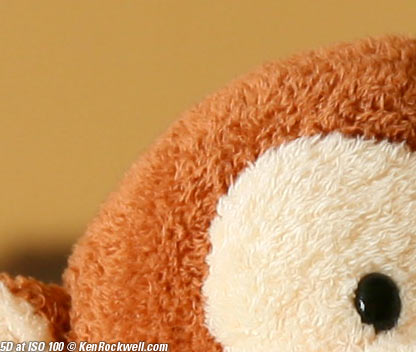 |
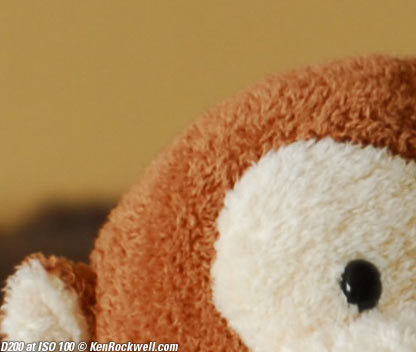 |
(the Nikon D40 doesn't bother with ISO 100) |
ISO 200 back to top
skip to ISO 50 ISO 100 ISO 200 ISO 400 ISO 800 ISO 1,600 ISO 3,200 ISO 6,400
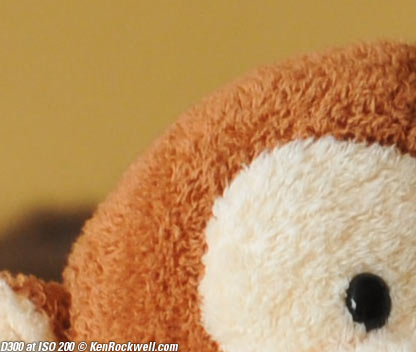 |
 |
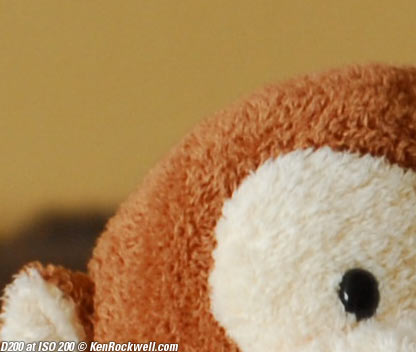 |
 |
ISO 400 back to top
skip to ISO 50 ISO 100 ISO 200 ISO 400 ISO 800 ISO 1,600 ISO 3,200 ISO 6,400
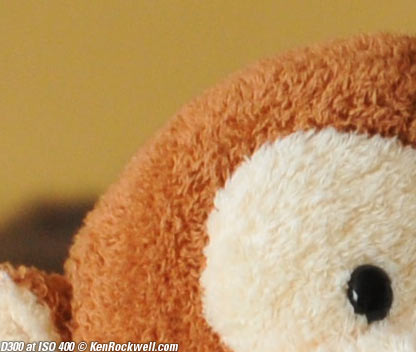 |
 |
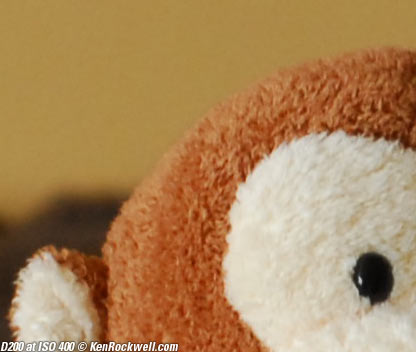 |
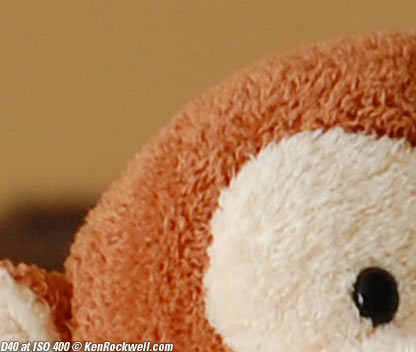 |
ISO 800 back to top
skip to ISO 50 ISO 100 ISO 200 ISO 400 ISO 800 ISO 1,600 ISO 3,200 ISO 6,400
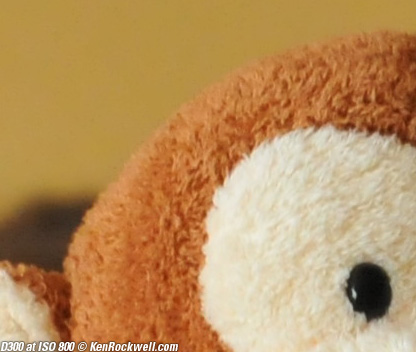 |
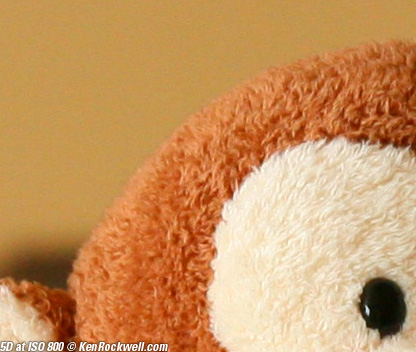 |
 |
 |
ISO 1,600 back to top
skip to ISO 50 ISO 100 ISO 200 ISO 400 ISO 800 ISO 1,600 ISO 3,200 ISO 6,400
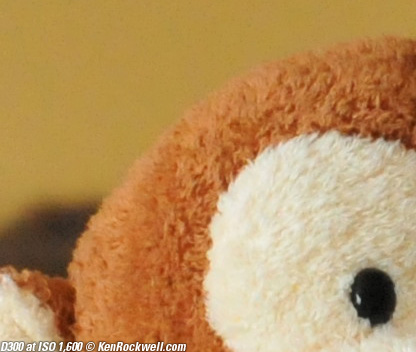 |
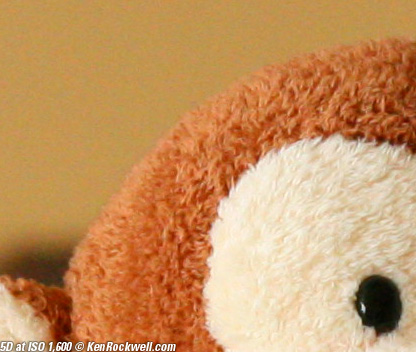 |
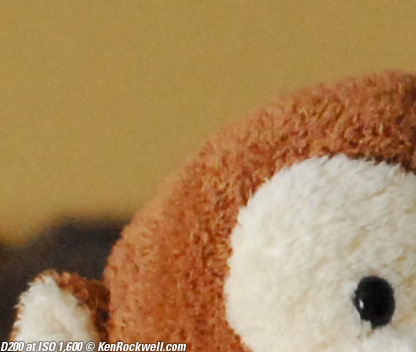 |
 |
skip to ISO 50 ISO 100 ISO 200 ISO 400 ISO 800 ISO 1,600 ISO 3,200 ISO 6,400
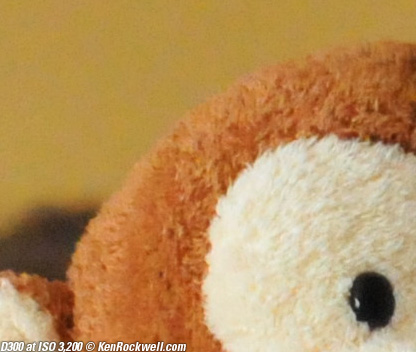 |
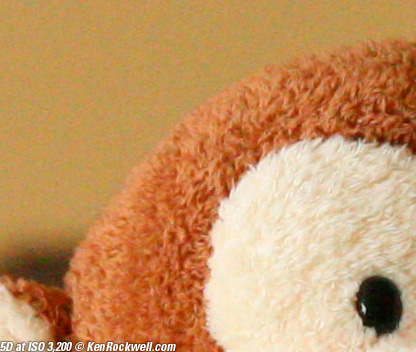 |
 |
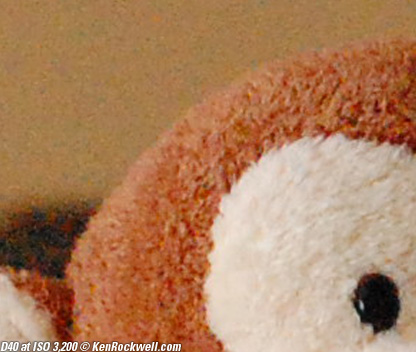 |
ISO 6,400 Note: D300 looks clean, but all the details in fur are gone, too! That's cheating.
skip to ISO 50 ISO 100 ISO 200 ISO 400 ISO 800 ISO 1,600 ISO 3,200 ISO 6,400
 |
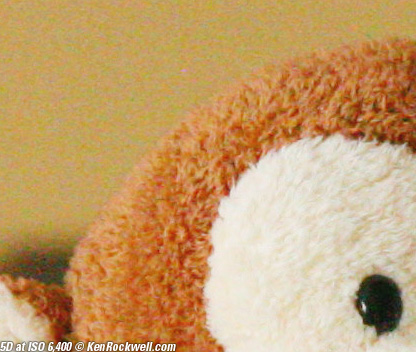 |
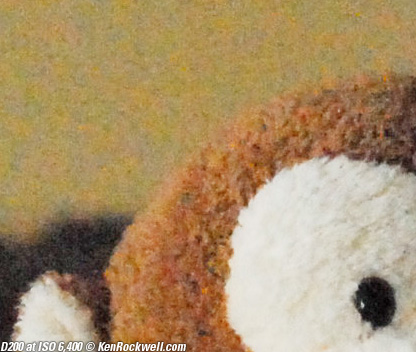 |
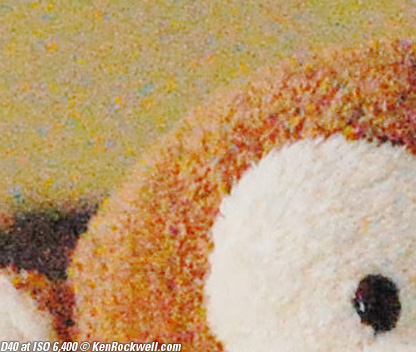 |
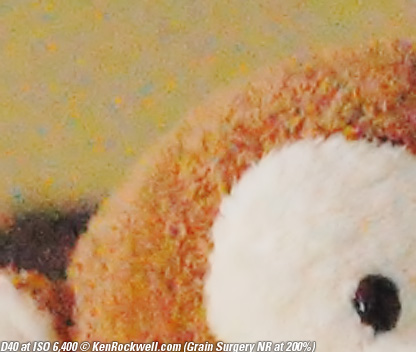 |
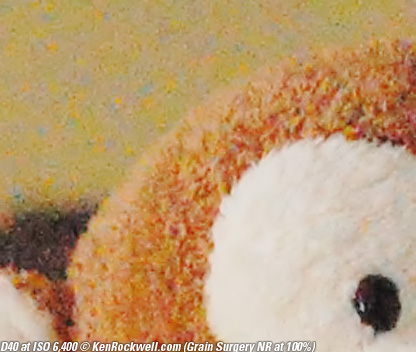 |
(note: only the D300 does ISO 6,400 directly. I pushed the others to ISO 6,400 in Photoshop)
The two bottom images are running the D40 image through Grain Surgery in Photoshop after pushing it to ISO 6,400.
Analysis back to top
The Canon 5D is clearly superior to anything else here because it doesn't get blurry at the highest ISOs. It has The Full-Frame Advantage. Look at the fur: the D300 wipes off all the fur and turns it into smooth skin at ISO 6,400! The D300 blurs everything to smithereens at ISO 6,400 to hide the noise, but it's like looking at the image though a veil. It's even more pronounced when I look at the full images on my 30" screen compared to these small clips. The D300 is a blur-o-rama at high ISOs. It's cheating! See Fallacies of Noise Measurements.
The D200 has a little more noise than the D300, but the D200 is also sharper. The only difference between them is how much noise reduction is used in the cameras' firmware. Change the camera defaults or add more as a Photoshop plugin, and you can make them match.
Heck, pushing the D40 to ISO 6,400 in Photoshop and adding NR, I can make the D40 have about the same amount of noise and detail at high ISOs as the other Nikons! The D40 is noisier than the D300 at ISO 6,400, but it's sharper!
When we see though this trick in the D300, the D300 is the same as the other Nikons. The D300 has a little less noise, but a little less detail and texture at the highest ISOs.
Sadly the D300 doesn't really shoot at ISO 100 if you use Auto ISO and Nikon's Adaptive Dynamic Range (ADR) feature as I do. Since the D300 defaults to ISO 200 mostly as a marketing gimmick, my D300 shots at ISO 200 in daylight have a small amount of visible noise at 100%, which I've never gotten in my D200 (or 5D) shots at ISO 100.
Wankers worry about noise; artists worry about color and tone. The D300 has far superior color and tone to anything else I've used.
Technical back to top
I made the same self-portrait a zillion times from a tripod with the self timer.
I used a Canon 70-200mm f/4 L IS on the Canon 5D and an exotic Nikkor AF 70-180mm f/4.5-5.6 Micro on the Nikons. I zoomed each lens to give the same field of view, which was 116mm on the full-frame Canon 5D and 85mm on the DX Nikons.
At f/10 all my lenses are about the same, and the 70-180mm Micro, while merely OK at normal distances, becomes extraordinary at the close distances at which I shot this. That's why it's called "Micro," and that's why I used this special lens. Just ask any venomous snake or tarantula photographer if you're curious about this rare 70-180mm Micro lens. The Nikkor is working at its sweet spot, while the Canon lens is at the end of its focus range. I spent all day shooting a lens-off to pick the sharpest lenses for these conditions before I got to shooting the ISO tests. The Micro even bettered my brand-new 85mm f/1.4 AF-D I got in anticipation of my D3. I didn't bother with the spectacular 24-70mm since it stops at 70mm, and I'm unsure how great it is or isn't at five feet. In any case, all these lenses are more than sharp enough to wring every last bit of performance out of these cameras, especially at f/10 where diffraction is the limiting factor.
No big deal; any of these lenses easily out-resolves any of these cameras at f/10. We're not seeing variation in sharpness from the lenses in these tests. We are seeing the The Full-Frame Advantage in the 5D; heck, I could, and next time probably should, use my crappy 20-year old Canon 70-210mm just to handicap the 5D as I did in The Full-Frame Advantage, where even with the bad lens the 5D easily wasted anything I could put on my Nikons. (Just wait until the D3 hits!)
The colors will never match. I shot each in the same manual exposure at f/10 with direct sunlight (fixed) WB. The D300 was set to STANDARD and +2 saturation, the D200 and D40 were set to Color Mode III and Enhanced saturation, and the 5D was set to +3 saturation. Sharpening and noise reduction were left at defaults on every camera.
Light was from a window under overcast skies.
I enlarged the smaller D40 images to match the D300 and 5D. I left the 5D and D300 images untouched since they are the same size. I left the D200 alone since it was close enough.
Exposure times for all cameras was:
ISO |
Manual Shutter Speed |
50 |
1/2 |
100 |
1/4 |
200 |
1/8 |
400 |
1/15 |
800 |
1/30 |
1,600 |
1/60 |
3,200 |
1/125 |
6,400 |
1/250 |
Since lenses and apertures were unchanged for entire test, any softening comes from the noise reduction, not from optics or camera shake. Heck, the high ISOs were at the fast shutter speeds, and ISO 400 was the most susceptible to any camera/pod shake. Another reason I used the Micro-Nikkor 70-180mm ED-IF AF-D was because it has its own tripod socket. Each Nikon hung off the end of the lens while the lens was mounted to the pod in the same place.
Depth of field, even at f/4.5, was more than enough for the entire monkey.
Conclusion back to top
All the DX Nikons are about the same. There is more variation from one speed to the next, or in the camera's use of noise reduction which you can do later in software, than there is from any DX Nikon to the next. The D300 has the least noise of the Nikons at high ISOs, but that's because it's also FUBARing (blurring) the image almost to beyond all recognition at high ISOs just to smother the noise.
The 5D is the easy winner for high ISOs, because it stays sharp while the Nikons' noise reduction blurs the images along with the noise. I crown the 5D because it has the highest detail (signal) to noise ratio. With this, I can apply NR in software and get the smoothest image of all if I let it get as soft as the Nikons.
Get a D300 for its spectacular treatment of bold color and outstanding highlight rendition. Don't throw money at a D300 if all you want is better high ISO performance.
If you want better high ISO performance, get a 5D which costs about the same as a D300.
If you're loaded, I expect the Nikon D3 will be at least as good as the Canon 5D due to The Full-Frame Advantage. For instance, the D3's US User's Manual says (page 299) that the D3 doesn't use any noise reduction (blurring) until you hit ISO 2,000, while the D300's US User's Manual (page 263) says the D300 uses noise reduction starting at ISO 800.
This means you're blurring your images on the D300 at ISO 800, but at ISO 1,600 the D3's images are still unfettered. Noise reduction tries to leave sharp edges alone, but it smoothes over milder image textures along with the noise.
In actual use, the D300 can't use ISO 100 with Auto ISO as I always shoot all my cameras. (Auto ISO does nothing, unless the light gets too dim for a sharp shot, in which case only then will it start increasing the ISO.) Sadly, the D300 defaults to ISO 200 most of the time, and all of the time in Auto ISO, so in actual daily use, my D200 is cleaner because my D200 defaults to ISO 100 while the D300 is running at ISO 200 in broad daylight. My D300 shots show just a little noise in blue skies at ISO 200, while the others don't. That's another day's test.
Everyone's preferences of noise vs. detail will vary. The absolute detail (signal) to noise ratio is about the same in all the Nikons.
Ignore me, look at the results and gauge for yourself. If I photographed people I'd probably prefer the softening of too much NR.
Since most of these cameras have options to increase or decrease the noise reduction, there are far too many variations for me to try against each other meaningfully. I leave these further experiments to you, my esteemed readers. I may try my D300 with less NR and see what happens.
PLUG
If this just saved you a few thousand dollars, or you find this as helpful as a book you might have had to buy or a workshop you may have had to take, feel free to help me continue helping everyone.
Thanks for reading!
Ken

